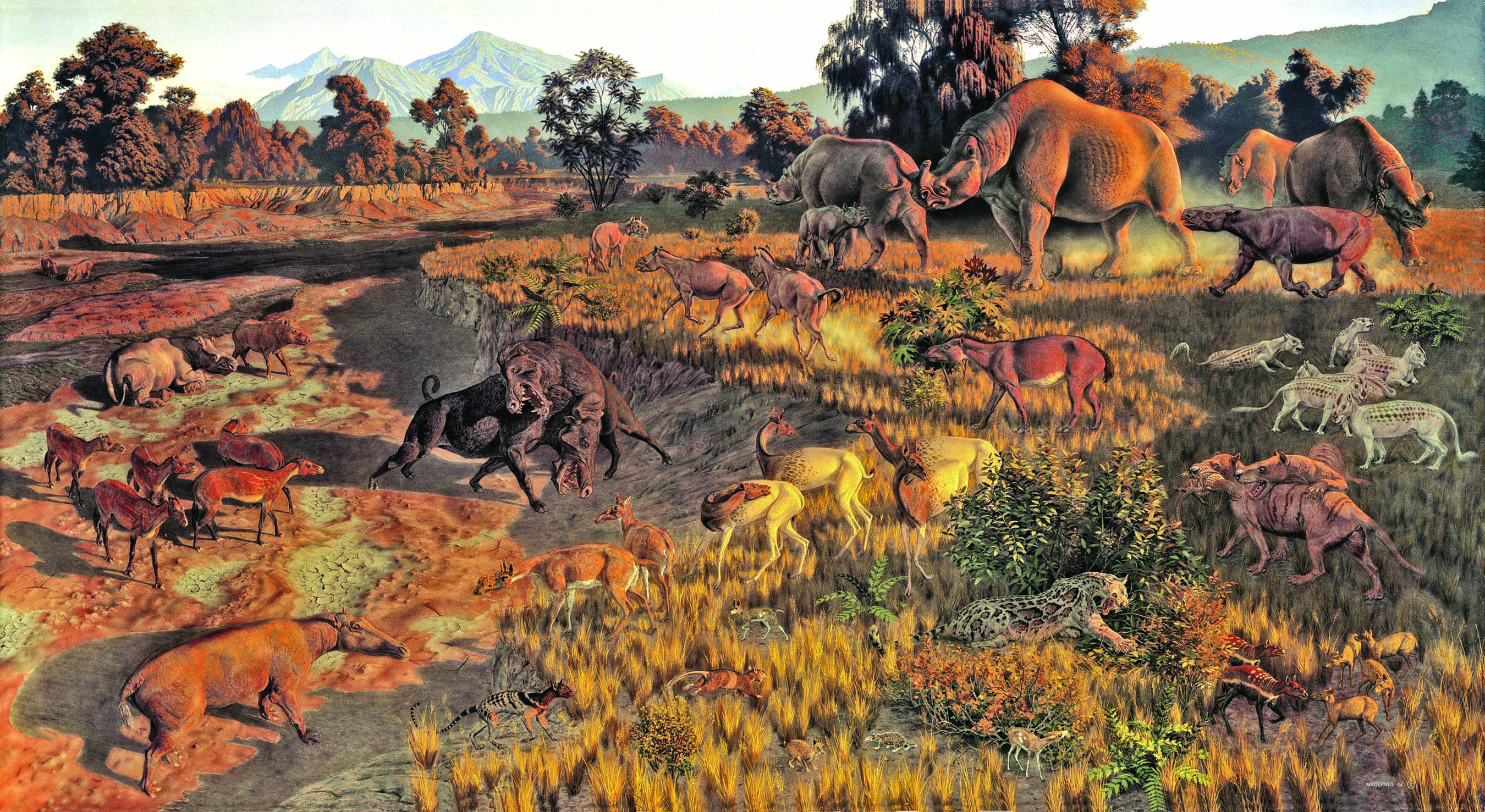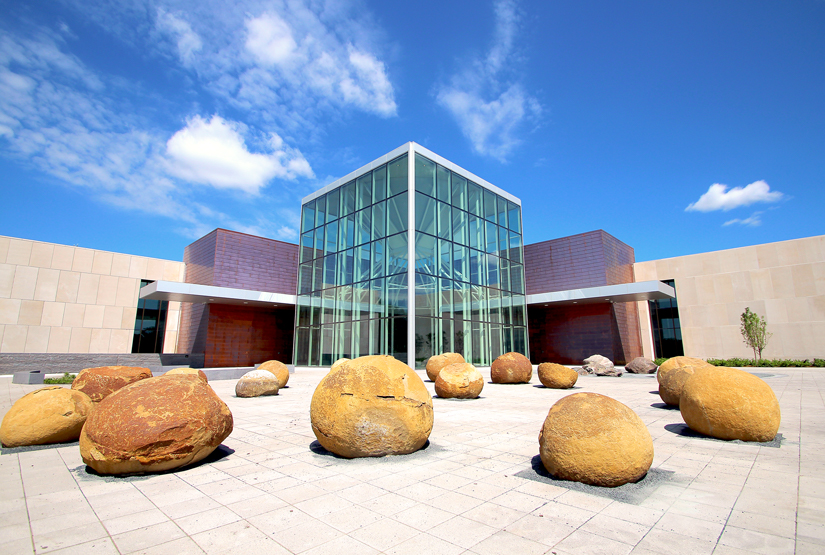At the beginning of the Tertiary Period about 65 million years ago, the last of the seas that had come inland drained away. The land of what is now the central United States was a nearly flat floor of the ancient seas. In the western part of this land, however, volcanoes were erupting and starting to lift up the land. The Rocky Mountains pushed up from the earth and rose to be hundreds to thousands of feet high. This took millions of years. Mighty rivers rushed eastward from the Rocky Mountains, carrying mud, silt, and other sediments which covered up vegetation (plants) in their paths. The rivers also formed gullies by eroding (washing away) land.
As the water receded (went back), reptiles, mammals, insects, and plants lived on the land. Huge swamps were also formed, creating a good environment for crocodiles, large amphibians, and other animals and plants.

Figure 19. The Cenozoic Era is sometimes called the “Age of Mammals.” After the dinosaurs became extinct, warm-blooded animals took over. (SHSND)
Because the process of water invading the land and then receding happened over such a long period of time, climate changes took place during this time, too. The climate was tropical at times so that palm trees and tropical flowers grew well. Thick forests of redwoods, sequoias, and other trees developed and grew to be gigantic. Many fossils of these ancient (very old) plants and animals have been found in North Dakota.

Figure 20. Brontops was a huge elephant-sized mammal that lived in North Dakota about 35 million years ago. (ND Geological Survey)
After the last of the ancient seas had drained away, layer after layer of rotted trees and other vegetation accumulated (piled up) in swamps over millions of years. Pressure from the heavy weight and heat from the earth turned these mats of vegetation into the fossil fuel called coal.• Solid fossil fuel created from land vegetation that had been squeezed by pressure for millions of years
• Formed during Cenozoic Era
Coal, petroleum, and natural gas were formed in a similar way by heat and pressure, but petroleum and natural gas were formed from plants and animals that lived in oceans and are a lot older than coal. Because they had many more millions of years to form, petroleum and natural gas had a much longer time to be exposed to great pressure and heat. This caused them to become a liquid (petroleum) or a gas (natural gas).

Figure 21. Mesohippus (three-toed horse). The skeleton of a Mesohippus is on exhibit at the Cowboy Hall of Fame in Medora, North Dakota. Mesohippus was only about two feet tall and lived in North Dakota about 30 million years ago. (ND Geological Survey)

Figure 22. Mesohippus (three-toed horse). (ND Geological Survey)

Figure 23. Huge petrified tree stump, probably from a Bald Cypress tree, being excavated from rocks that are about 60 million years old in western North Dakota. (ND Geological Survey)
The kind of coal that was formed in North Dakota is called lignite.• Very soft coal that contains a lot of moisture
• Burns fast and does not give off as much heat as other coals
• Surface-mined
• Formed during Tertiary Period of Cenozoic Era North Dakota has a great deal of lignite, but it is a very soft coal that contains a lot of moisture. It burns fast and does not give off as much heat as other types of coal.

Figure 24. Pembina River Plaza. These “cannonballs” greet visitors to the North Dakota Heritage Center & State Museum. A circle of 17 cannonball concretions showcases a unique geologic feature found in North Dakota. These 60 million-year-old sandstone spheres formed in layers, much like a pearl forms around a grain of sand. (SHSND)
Harder coals that are found in the eastern part of the United States are found deeper underground than lignite and are mined differently from lignite. Because lignite is close to the surface, it is surface-mined• Top layers of soil are scraped away and coal is scooped up with giant shovel-type machines
• Lignite is mined this way which means that the top layers of the soil are scraped away and the coal is scooped up with giant shovel-type machines. The largest lignite mines are in Mercer and Oliver counties, around Beulah and Center, North Dakota. There are other places in the western part of the state that also mine lignite. Most of the lignite is used right here in North Dakota in power plants that make electricity.
Mammals that lived during the Tertiary Period in the area we now call North Dakota included camels, tiny three-toed horses, and a type of rhinoceros with short legs. Most of these prehistoric mammals have been extinct for many millions of years.
Fossils of many of the prehistoric animals and plants have been found in North Dakota. Some of the best plant fossils are those which have become petrified. Petrified wood• Stone formed from minerals filling in cells of wood as it decayed
• Looks exactly like the plant that had been there in the first place, except it is stone
• Petrified forest located in Badlands looks as if it turned to stone, but actually another process took place. As the cells of the wood decayed, minerals filled in where the cells had been. In this way, when the wood became completely petrified, it looked exactly like the plant that had been there in the first place, except it was now stone.
A lot of petrified wood is found in western North Dakota. Some areas contain so much petrified wood that they are called “petrified forests” and contain petrified stumps and logs. There is a petrified forest in the Badlands of Theodore Roosevelt National Park with petrified wood about 60 million years old. Some of these stumps are 10 feet in diameter (measured across). The trees may have been 100 feet high when they were living.
The largest piece of petrified wood on display in the state is at the Long X Trading Post, a visitor center in Watford City, North Dakota. It is a petrified tree stump that is six feet tall, eight feet in diameter, and weighs 8½ tons (17,000 pounds).

Figure 25. Teredo-bored petrified wood. This sixty-million-year-old petrified wood is North Dakota’s state fossil. (ND Geological Survey)
North Dakota was one of the first states to have a state fossil. The state fossil of North Dakota is the 60-million-year-old petrified wood called Teredo-bored petrified wood• Pronounced ter-ee-doe
• North Dakota’s state fossil
• 60 million years old
• Little clams called teredos drilled tiny holes into wood before it fossilized Teredo-bored petrified wood got its name because little clams called “teredos” drilled tiny holes into the wood before it fossilized. Sometimes those clams are called “shipworms” because they also bored holes in wooden ships.
Ever since the Paleozoic Era, many climate changes took place on the whole Earth, including the area that is now North Dakota. There were times when this area had a tropical climate, but there were also times when the temperature was very cold with snow and ice covering the land and lasting for millions of years. This pattern of climate change from hot to cold happened over and over again.
Artifacts of North Dakota’s geologic past greet visitors at the entrance to the North Dakota Heritage Center & State Museum in Bismarck, North Dakota. A circle of 17 concretions, nicknamed “cannonballs,” showcases a unique geologic feature. These 60 million-year-old sandstone spheres formed in layers, much like a pearl is formed around a grain of sand. The sandstone spheres are the namesake for the Cannonball River in North Dakota.
After having had a very warm climate for many millions of years, the climate again began to change during the Cenozoic Era. About 50 million years ago, the climate in what is now North Dakota was cooling off and becoming drier. By about 30 million years ago, the swamps had dried up and were replaced by grasslands. The climate was getting colder in other parts of the world, too. In Antarctica, great ice sheets were forming. Ice was also starting to form in the northern part of what is now Canada, and over the next 20 million years or so, the earth got colder.


